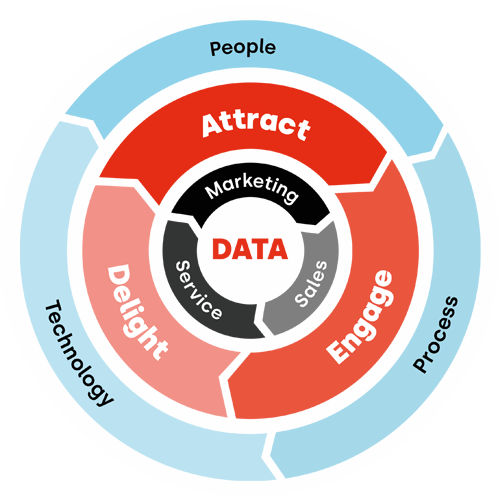Lead nurturing - how to increase the likelihood of SQLs in 5 steps
Lead nurturing is marketing slang for "building rapport with your leads. Those who successfully nurture leads increase their lead-to-customer ratio, or the number of leads that eventually become customers. Some companies already naturally do this very successfully, without calling it that. For others, it takes more awareness. In all cases, it pays to take a closer look at the lead nurture process and ask yourself: how adept are we at winning over customers and...could it be more efficient?
What is lead nurturing?
Did you know that most customer journeys are already largely (> 57%) completed before a customer first makes contact with a sales person? This is because most people first search for answers themselves, online. A good findability is therefore very important to get in the picture with prospects at all. It gives you the opportunity to deliver your business card early. Although it does not necessarily mean that visitors to your website are immediately convinced of your solution. And this is exactly where lead nurturing comes in.
Nurturing literally means feeding. In the commercial context, you bring your lead big (that is, closer to the purchase decision) by feeding them valuable information. You take them by the hand, guide them through the buying journey. That buying journey is also known as the funnel: leads start at the top of the marketing funnel and you slowly guide them down toward the sales funnel. The process of lead nurturing can usually be automated very well. After all, many leads struggle with the same challenges and issues. Questions that you can answer with valuable content.
You usually offer this content with e-mail marketing software.
Lead generation versus lead nurturing
Lead generation and lead nurturing are often mentioned in the same breath. Yet there is a clear difference. Lead generation is all about generating leads. Lead nurturing goes a step further. With lead nurturing you are actively engaged in building a relationship with the customer. You do this by helping the customer further in his search for a solution to a problem.
Many companies do lead generation, but not (or not consciously) lead nurturing. A common pitfall is that sales contacts the potential customer too quickly. We've all been there: you download a white paper and immediately you are approached by sales. Well-intentioned, but very compelling if you're not ready yet. The result? Sales misses the boat and there's a good chance that a few months later the prospect will join forces with another party (who knows how to time things better). Frustrating right!
The good news is, you can do something about it! Further on, we dissect the concept of lead nurturing into a step-by-step plan. In fact, lead generation is the first step of lead nurturing.
Lead generation versus lead nurturing
Other common terms in relation to lead nurturing are marketing qualified leads (MQL) and sales qualified leads (SQL). Simply put, lead nurturing is a way to turn an MQL into a SQL.
That starts with lead generation, as you need an e-mail address to ensure you stay in touch with visitors. A proven strategy is to offer valuable content such as a scan, calculation tool or ebook in exchange for an e-mail address. Visitors interested in this convert to MQLs. Then you can nurture them, by constantly offering these leads appropriate content that answers the questions of that moment. Eventually, some of them become "sales qualified," aka prospects. These prospects already know what your company stands for and what products and services you offer. Some important concerns about your product have already been addressed during lead nurturing. This makes it easier to convert the prospects.
Lead nurturing in 5 steps
How do you increase the likelihood of SQLs? The lead nurturing process is divided into several steps:
- Attracting leads.
You can also call this step lead generation. At this stage, many potential customers do not know of your existence at all. The goal in this phase is to attract customers to your company.
The most common way to do this is through inbound marketing. The customer has a concrete question and arrives at an article on your website via a search engine. Another popular method of coming to the attention of the target audience is through social media. Sometimes companies also choose to advertise, for example in search engines. These ads are not set up to persuade the customer to buy right away, but their purpose is to attract visitors.
Whatever channel you use to attract visitors, the next step is to persuade visitors to leave their contact information. You often do this by offering valuable content in exchange for an e-mail address, such as a newsletter or white paper.
- Qualify
Not everyone who leaves contact information is a potential customer. And not every potential customer is looking for the same information. Take, for example, the head of the HR department and a general manager. They may both be interested in payroll software. However, they are each looking for different information. For a general manager at a small company, payroll is just one of their occupations, while it is about the basic activity of an HR person at a large company. Depending on who downloaded your white paper, offer different content. Many companies also segment their leads by industry. A regional manufacturing company has different issues than a medium-sized company that also has branches in Germany and Belgium.
In addition to qualifying based on target audience, you also look at how interested the customer is. Did someone only download your white paper or did they also view all kinds of other content? Is someone already interested in what your solution should cost? This too affects what information you offer.
- Connecting with the customer.
In the third phase of lead nurturing, you engage with the customer by offering valuable information. Here you follow the thought process that the customer goes through on the way to a purchase. In the first phase, you focus on the customer's problem. Later, you position your product or service as the solution to this problem. In the next phase, you address the customer's objections.
Although you generally offer this content automatically, it can be very interesting to send a personal email. This is also a good option if you have little content that matches a lead's situation.
- Transfer to sales
At some point, the information you can offer via email is no longer enough for the lead. This one wants more information and that is when sales comes on the scene. Often marketers offer content at this stage that leads to a conversation with sales. The lead receives an offer for an on-site demo or a trial period. If the lead accepts, marketing passes the baton to sales.
- After sales
Once the lead has finally made the purchase, it really begins. It is more important than ever to strengthen the relationship with the customer. Many companies have multiple products on offer. Keeping the bond warm can then help generate additional sales. Customers can also become an important ambassador for your company.
Why apply lead nurturing?
Not everyone who comes into contact with your company is immediately ready to make a purchase. Very often potential customers are still orienting themselves.
Lead nurturing is a method you use to bind these people to you. You make sure they stay in touch with your company. With lead nurturing you increase the efficiency of the entire sales process, that is, of both marketing and sales. The process of lead nurturing provides important insights. For example, about the specific context or issues the customer is facing. In part, you can glean this from the type of content the customer reads.
Sales uses this knowledge to better empathize with the customer during initial conversations. Because you have already built up trust with the customer during lead nurturing, the chances of a successful outcome of the sales process are also higher.
How do you ensure relevant content?
If you want to put lead nurturing into practice, you need to know what information the customer needs. You determine this on the basis of the buyer persona and the customer journey.
The buyer persona is a fictitious customer profile, containing the characteristics of your (ideal) customer.
It's a tool to help you empathize with this customer, so that's why you describe, among other things, what the main challenges and motivations are. Most companies have several buyer personas, often even for the same product.
The process these customers go through before they make a purchase is called the customer journey. The persona's information needs differ at each stage of the customer journey. It is therefore important to match the content you use to nurture your leads to the persona and to the customer's buying journey.
A process of continuous improvement
Setting up a lead nurturing campaign is not a one-time action, but a continuous process. During implementation, you collect all kinds of data about the target groups. You use this to further refine lead nurturing.
First, you collect a lot of data about the behavior of your leads. Which content is read the most? Where in the process do most leads drop out? What percentage of visitors end up becoming marketing or sales qualified leads? In addition to the input from data analysis, alignment with sales also remains important. Are the leads that move on to sales warm enough? Are they still getting questions that should perhaps be answered at an earlier stage?
You use the information from data and the feedback from sales to further improve your lead nurturing. You close gaps in the content or adjust the workflow for a specific target group. As your campaign runs longer, you also have an internal benchmark. If it appears that the number of sales qualified leads is suddenly declining, you know something could be going on.
How do you apply smart automation?
Customer contact is always about a personal touch. Relationships are built with people, by people. However, there are smart ways to automate lead nurturing. So that if you decide to approach your leads personally, you do so for the leads that are waiting for personal contact. Good timing is everything. And a platform like Hubspot helps with that.
HubSpot is a cloud-based platform that helps companies structure their marketing and (after)sales. HubSpot combines several applications important to the sales process, such as a CRM, e-mail marketing software and a CMS. Because you combine different applications in HubSpot, it's a lot easier to organize and optimize your lead nurturing. For example, your email software links effortlessly with your CMS, allowing you to personalize your emails. In HubSpot, store all customer contacts. If one of your account managers talks to a lead at a trade show, you'll see this right away in the same application. The same goes for questions that come in to customer service. Because all data is stored in one database, you can analyze data about your entire sales process. You easily build dashboards, and if you want deeper analysis, export the data from the system.
Want to learn more about how HubSpot can support your business with Lead Nurturing? Then get in touch and we'll be happy to think with you.

Want to get the most out of HubSpot? Subscribe to our newsletter, follow us on LinkedIn, or attend our HubSpot User Days!
Explore HubSpot User DaysShare this
You May Also Like
These Related Stories

From sales funnel to modern marketing flywheel: switch?

10 KPIs for Sales Managers: reliable & scalable results

